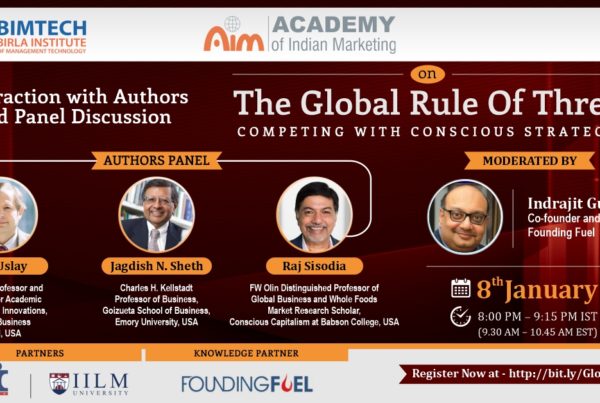Published: Jun 12, 2008 in Knowledge@Emory
A jump in gas prices that shows no sign of abating has stalled consumer demand for gas-guzzling vehicles, knocking the wind out of American car manufacturers that tied their profits and their future to high-margin SUVs and trucks. In the long term the U.S. carmakers have the ability to survive, say faculty at Emory University and its Goizueta Business School, but they will have to be prepared to make significant changes to their operating model.
A swirl of bad news surrounding U.S. car manufacturers makes it evident that they need to do something.
General Motors Corp. announced it will shut down four plants that build pickups, SUVs and medium-duty trucks, and said it will likely revise or eliminate its Hummer line of oversized SUVs.
Ford Motor Co., which does not expect to turn a profit before 2009, is being stalked by billionaire investor Kirk Kerkorian, who recently boosted his investment in the beleaguered car company. The company also announced plans to lay off about 2,100 salaried workers on top of the thousands of union jobs that have been slashed.
Chrysler Corp. previously announced it would cut about 12,000 jobs through the end of 2008. The company was purchased by German carmaker Daimler in 1998 for about $37 billion only to be sold last year to a private equity group for about $7.4 billion.
From the industry’s beginnings around the early 1900s, “bigger is better” has been the mantra among American automobile manufacturers. The strategy suffered a setback in the early 1970s when gas supplies were temporarily choked off after a Middle East conflict, prices rose and U.S. consumers flocked to smaller cars, but once supplies rose and prices moderated, the American appetite for big vehicles returned.
The initial surge in consumer demand for small cars may have moderated after awhile, but it provided a foot in the door for a new set of competitors: Japanese car companies. Their early offerings tended to lack critical attributes, such as style and performance, but Honda, Toyota and other Asian companies worked hard to improve their products in the 1970s and 1980s even as American auto companies were plagued by labor problems and gained a reputation for poor quality control.
“You could say that for a long time American car companies were giving consumers what they wanted,” says Russell Coff, an associate professor of organization and management at Goizueta. “Until the first oil shocks, Americans liked their big vehicles. But those first price-hikes were not that burdensome on an inflation-adjusted basis, so the demand for minivans, SUVs and other large vehicles rebounded. Unfortunately, the car companies rigidly adopted the big-car strategy and as a consequence got caught with their pants down in the latest round of gas price hikes.”
The economics of the manufacturing process were a big driver behind their embrace of the big-vehicle strategy. U.S. consumers generally link price to size and expect to pay less for a smaller car; even though auto companies say that all else being equal, the manufacturing costs for a smaller vehicle are not that much lower than for a bigger one. But the focus on price meant that U.S. car companies were missing out on other parts of the picture.
Companies Cut Costs but Ignore Other Strategies
During the past few years U.S. car companies successfully renegotiated many labor contracts and reduced their workforce, bringing operating costs closer to that of their Japanese and other competitors, notes Coff. The carmakers also improved their quality control efforts. But they still missed some key elements.
“Domestic car companies fixated on labor costs while ignoring manufacturing flexibility,” says Coff. “They did address labor costs, but that’s just one element. Innovation and flexibility are also important, and they missed the boat when it came to those areas.”
He says that U.S. car companies are researching alternatives to petroleum like fuel cells—battery-like devices that use hydrogen cell and oxygen, and other elements to produce electrical power—but says they’re a long way from being market-ready.
“Right now hybrid engines are seen as a near-term solution,” he notes, referring to vehicles that utilize a combination of a small, traditional gasoline powered engine and an electric motor to reduce emissions and minimize gas consumption. “The problem for U.S. car companies is that right now they’re still licensing the technology, primarily from Japanese carmakers. That arrangement bleeds off a portion of their profit, damaging their bottom-line results.”
Structural and Market Conditions May Impede a Recovery
Unlike their European and Asian competitors, U.S. carmakers tend to have a short-term focus, which can harm their sales prospects in the long term, observes Reshma Shah, an assistant professor in the practice of marketing at Emory’s Goizueta Business School.
“The U.S. manufacturers forgot that customers can easily change their mind about purchasing an automobile,” she says, “but carmakers can’t adjust their output that fast.”
During the fuel shortages and price hikes of the 1970s Americans first began flocking to fuel-efficient Japanese cars, recalls Shah.
“In response, U.S. auto companies pledged to start producing smaller cars that would feature better gas mileage,” she says. “Instead we got trucks and SUVs. European and Asian carmakers tend to spread their profit centers out over a variety of vehicle styles, while the U.S. companies grew accustomed to depending on trucks and SUVs for about 70 percent of their profits. So when demand fell for those lines, the U.S. companies were unable to make up the revenue elsewhere.”
Perhaps part of the problem is that the American carmakers never truly embraced global production, with the insights that flow from that kind of diversity, according to Shah.
“Honda, Toyota and others learned to meet the demands of a variety of markets and their lines reflect that global outlook,” she says. “In contrast, the U.S. car companies were focused on the domestic market. And in contrast to much of the world, Americans traditionally wanted big vehicles.”
The U.S. companies may finally be moving in the right direction, focusing on alternative kinds of engines and shuttering the factories that produce the biggest vehicles.
“But many consumers may wonder if much of the effort is window dressing,” says Shah. “Right now the carmakers here say they’re focusing on fuel efficiency and environmentally friendly vehicles. Who is to say that won’t change to another attribute, like color or handling, in a year or so?”
They key is to become adaptable, she adds. “Gas prices can fall as well as rise,” cautions Shah. “If consumers change their minds again, then carmakers here need to have a diversified portfolio of cars and trucks that can quickly meet that change in demand.”
So far, she says, the track record of the car companies is less-than stellar.<
“During the past few years American car manufacturers focused on renegotiating labor contracts, and boosting productivity partly through major layoffs,” she says. “But what good is all that if nobody is buying the cars that are on your lot?”
Gas Prices the final blow?
The turn of events has “a deeply ironic aspect,” according to Ray Hill, an adjunct professor of finance at Goizueta.
“The American car companies sink lower and lower for years, in part because they never dealt with the legacy of high cost and inflexible labor,” he says. “They finally go through the pain of restructuring their labor relations–cutting the workforce and getting rid of the huge health care and pension costs–and now they get hit by high gas prices. I think it would be interesting to see if this could be the final blow.”
In addition, Hill does not think any cross-border mergers are likely, given the results of the last one. “The experience of Daimler acquiring Chrysler and then spitting it back out a few years later doesn’t provide a very good historical model,” he observes. “I don’t know who else in Europe would try that trick again and I don’t know why the Japanese car companies would think it was worth the effort.”
Hill adds though, that a merger of two U.S. companies might be more likely, although the options are limited.
“Chrysler is owned by a private capital group which made the acquisition only by having Daimler retain some of the liabilities,” he says. “Chrysler would only be sold for cash and I don’t see Ford or GM doing that; and I don’t see how Chrysler or anyone else would acquire Ford or GM. That only leaves a merger between GM and Ford which could bring about further “rationalization,” or downsizing. While it might make sense, I suspect that management is not ready at both companies, given the restructurings they have both been through.”
Referring to U.S. carmakers’ long love affair with big vehicles, Hill notes that “I don’t think companies can ever lose by offering what customers want. But the question is whether they can adapt to changing market conditions—and there is not much evidence that the US car makers can.”
He says there is a “huge risk” that the price of gas will drop from the $4 a gallon mark, “and by the time car makers shifted out of SUVs the price of gas could fall and SUV demand would go back up.”
Hill doesn’t think that alternative energy breakthroughs, like hybrid vehicles, will do much to improve the competitive position of U.S. car makers. “I would suspect that any “breakthrough” (if there is one) will quickly be copied by other companies, nullifying any competitive advantage,” he says. “As a result, consumers’ decisions between car companies will continue to be driven by such factors as quality and styling.”
Will a New Paradigm Provide an Answer?
“There’s no question about a future for U.S. automakers,” says Jagdish Sheth, a chaired professor of marketing at Goizueta and corporate strategist. “But there is a question about what they’ll look like in the future.”
Decision makers at car companies, like other industries, often suffer from the “curse of incumbency,” says Sheth, who last year wrote a book titled The Self-Destructive Habits of Good Companies: …And How to Break Them. “It takes a long time for an established leader-company to change its culture, while a new entrant that has no legacies can easily execute on a new paradigm.”
In the short term, he says, growth in the auto-manufacturing industry will likely shift to emerging markets that include China, Russia, India, and Brazil where demand is growing at a rapid pace. During that time, he says, for their short term survival U.S. automakers must now start to participate in the growth of such emerging markets as China, India and Russia.
At the same time, he says, U.S. automakers may either assemble cars for others or let others assemble their cars. “U.S. companies are likely to break up existing vertical integration arrangements, and encourage contract manufacturing and assembly of cars,” he adds. “They will basically serve as designers and depend on dealer-owned networks to sell the vehicles.”
The goal of the car companies, he notes, will be to generate enough cash to carry them through while they develop long-term revitalization and reorganization plans.
“It’s not that unusual in other industries,” says Sheth. “Think about consumer electronics or apparel companies. With the rise of large national retailers including CarMax and AutoNation, cars will become private label goods.”
In the short term, he says, this approach will require less capital and will enable the outsourcing providers to more fully utilize their existing plant capacity.
The manufacturing model today is completely different than the one that U.S. car companies are based on, adds Sheth.
“At one time manufacturing plants were hardwired to build a certain type of vehicle,” he says. “Now they’ve got to be re-designed with flexibility built in, so the same plant that builds large cars or SUVs can quickly shift to small car production; or from building gasoline power plants to hybrids.”
On a wider scale, Sheth says the global auto industry will likely follow “the rule of three,” a concept he developed that postulates that any major market will eventually be dominated by three major full-line car makers that together control from 70% to 90% of capacity and are surrounded by a constellation of smaller, niche firms that are market- or product specialists.
“Toyota is likely to emerge as one of the three global players,” says Sheth. “GM may also retain its position, while Volkswagen or Nissan/Renault could emerge as the third major player, especially if there are more mergers and acquisitions.”
Ford, which has already divested most of its Aston Martin, Jaguar, Land Rover and Volvo luxury division, may ultimately jettison its automobile operations and become a niche player focusing on trucks, he adds, while Chrysler may be sold to a company from Europe or more likely from an emerging economy that wants a foothold in the United States.
New Opportunities, But New Challenges
American auto manufacturers face a special challenge, he adds,
“An entire generation of car buyers has been turned off to the idea of buying American vehicles,” Sheth says. “They automatically look to Toyota, Nissan, Volkswagen, Honda and other transplant companies, and are not aware that the U.S. carmakers also build cars for their lifestyle. GM’s Saturn, which is essentially marketed as a stand-alone company, was a good idea. GM also did the right thing when it redesigned the Cadillac line to appeal to a younger generation. But those successes represent only a small part of GM’s overall operations.”
Today’s increasingly “flat” or global market offers opportunities and challenges, says Sheth.
“At one time, companies were protected from international competition by their countries’ restrictive trade, distribution, financing and other laws and regulations,” he observes. “But across the world, restrictive barriers are falling as nations embrace free-market policies. This can enable a company to expand in ways that were unheard of in the past. But it also forces every company to work harder to maintain or expand its position in any market.”




